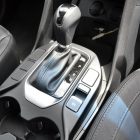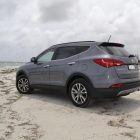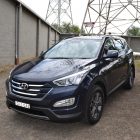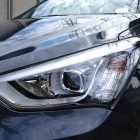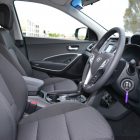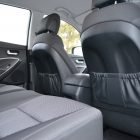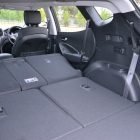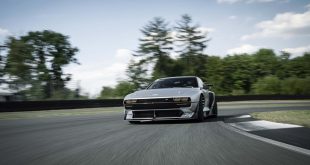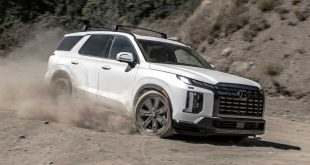The previous generation Hyundai Santa Fe was an ordinary SUV that does the job for most things it was designed to do. It’s big, it tows well, it goes okay as long as you keep it on-road, and it’s well priced. Now there is an all-new model and unlike the model it replaces, the 2012 Hyundai Santa Fe is anything but ordinary. For a start, it looks sharp, modern and distinctive, further signifying the Korean car maker coming of age from a humble budget brand that offers nothing but cheap and cheerful to a serious player with a bold design statement.
Now in its third generation, the 2012 Santa Fe has grown a little larger in all directions except height compared to the outgoing model. As a full-size SUV, some of its direct competitors are the Ford Territory, Mitsubishi Outlander and Mazda CX-9.
The Santa Fe is available in 2 engine options – a 2.4-litre direct injection petrol or a 2.2-litre turbo diesel. Both engines are offered with either a six-speed manual or six-speed automatic transmission paired with an active on-demand 4WD system. The range starts with the Active base model (as tested), Elite in the mid-spec (as tested) and the top of the range Highlander model.
Design & Comfort
Hyundai’s styling of late has been one that inspires confidence and elegance, and the new Santa Fe is no exception. It is a good looking SUV at every angle with all the lines and curves at the right places. From the striking headlamps and aggressive hexagonal front grille to the smooth flowing roofline and short overhangs, the Santa Fe looks tough yet intrinsically elegant and upmarket.
Hyundai calls its design theme ‘Fluidic Sculpture’, so their cars are meant to look like they are moving all the time. The new Santa Fe’s styling, called ‘Storm Edge’ is another evolution of this design language. Compared to the old model, the 2012 Santa Fe is a much better looking car, and is also certainly one of the best looking SUVs in its class.
The graceful styling carries into the interior. Whether it is for the futuristic yet functional dashboard, or the stylish yet comfortable seats, the Santa Fe’s spacious cabin is inviting and a pleasant place to be in. It has room for five adults over the first and second row seats, while a third row is good for two children. However, larger front passenger may find the legroom a little tight due to the big and chunky dashboard.
Useful storage spaces are aplenty around the cabin including a sizeable cargo area with under-floor storage.
Score: 8.5/10
Performance & Handling
The model we tested has a 2.4-litre four-cylinder petrol engine developing 141 kW of power and 242 Nm of torque. Whilst it is a smooth unit, to get the 1.7 tonne family SUV moving requires pushing the right pedal fairly far, more so if the seven-seater is all packed up with the whole family and all the gears for a long holiday trip.
This calls for a need for a 3.5-litre V6 petrol, which sadly is not available. In that sense, the 2.2-litre turbo diesel would be the better pick if you don’t mind sacrificing a bit of refinement. Having said that, the diesel unit is hushed at cruising speed and only ever becomes vocal at higher rpms.
In contrast to the weak motor, the six-speed automatic transmission seems to deliver every ounce from the crankshaft to the road in a smooth and responsive manner. This is especially so when mated to the diesel.
Despite its size, the Santa Fe is surprisingly easy to handle around town and navigate through tight spaces thanks to its excellent turning circle and standard rear view camera. Its MacPherson strut front and multi-link rear suspension setup is tuned for comfort more than anything. That combined with the thick tyres mean the Santa Fe will soak up most ruts and bumps to give its occupants a smooth and comfortable ride on our pimply roads.
On country roads, the Santa Fe’s ride remains supple. With 15 per cent more rigidity than its predecessor, the new Santa Fe also handles better around the corners. But its driving dynamics are far from outstanding as there are other cars in its class that offer a better driving experience, whether or not they are as easy to live with as the Santa Fe is another story.
With improved aerodynamics, the new Santa Fe pushes through air at freeway speed more effectively resulting in a smoother ride with less road and wind noise.
Off road, the Santa Fe is surprisingly capable. Put it into 4WD lock mode, the big SUV will happily plough through most rough terrain with ease. The differential’s effectiveness in managing slip adds to the car’s ability to drive over mud and sand. The Down Hill Brake Control (DBC) also works a treat by doing the braking for you when descending a slope, all you have to do is steer.
Score: 8/10
Quality
Take away the badge, you wouldn’t have a clue you are in a Hyundai. To us, the 2012 Santa Fe is the Korean manufacturer’s most well built car so far. Quality soft touch plastics are used for the dashboard and door trims, panels are well aligned, gaps are tight and all knobs, switches and buttons have good fitment.
The cabin feels almost upmarket and there is also no noticeable rattles or squeaks around the cabin, a further testament to Hyundai’s commitment to take on more established brands.
Score: 8/10
Economy
Due to the need to constantly push the weak 2.4-litre engine in order to get anywhere, the 2012 Santa Fe is not exactly fuel economical – 10.2L/100km over our week long test covering 700 kilometres of mixed urban/freeway driving, as compared to Hyundai’s advertised figure of 9L/100km. Fuel consumption will suffer even more in city/urban driving.
However, the Santa Fe’s preference for RON91 fuel means it is still fairly cheap to run for a large SUV. If fuel economy is your major concern, the diesel version would be the one to opt for in this regard. It returned 8.2L/100km of predominantly highway kilometres.
Score: 7/10
Features
The Santa Fe Active we tested here is well equipped with a host of standard features. Front, side, curtain and driver’s knee airbags, Anti-lock brakes, Electronic Stability and Traction Control, Downhill Brake Control and Hill-start Assist Control (prevents the car from rolling back on a hill start) are all standard.
Also included are cruise control, automatic dusk sensing headlamps, rear view camera, Bluetooth, iPod connectivity and a 4.3-inch touchscreen LCD with MP3 CD player/Radio. For the avid camper, there are also four 12 volt power outlets (2 front, 1 rear of centre floor console and 1 rear cargo area).
The second row seats are forward folding with 40/20/40 split while the third row seats are 50/50 forward folding. All folded, you get a generous 1,615-litre of cargo space.
Moving up to the Elite brings a 7-inch touchscreen sat-nav, premium audio including sub-woofer and external amplifier, electric park brake, leather seats with 8-way power adjustment for the driver and push-button start.
The Hyundai sat-nav is also one of the best in the business, with clear and precise instructions and brilliant graphics.
Score: 8.5/10
Verdict
The 2012 Hyundai Santa Fe retains the same versatility and practicality of the previous model while adding a lot more style, quality and desirability to it. As a package, the 2.2-litre turbo diesel is the better pick as the 2.4-litre petrol feels weak and struggles to haul the big SUV around.
With an attractive pricing, good looks, decent handling and remarkable build quality, the new Santa Fe certainly stacks up to long time favourites such as the Mitsubishi Pajera, Ford Territory and Mazda CX-9. And for that, it is one SUV that is hard to look past if you are in the market for one.
| Price (Estimated Drive Away): | From $40,477 (2.4L GDi Active) – $53,867 (2.2 CRDi Highlander). As tested: $43,150 |
| Warranty: | 5 years/unlimited kilometres |
| Engine: | 2.4-litre, 4-cylinder petrol, 141kW/242Nm (As tested) |
| 2.2-litre, 4-cylinder turbo diesel, 145kW/421Nm (M/T) 436Nm (A/T) (As tested) | |
| Transmission: | 6-speed manual |
| 6-speed automatic (as tested) | |
| Fuel Consumption (Combined): | 9 (2.4GDi MT/AT), 6.6 (CRDi MT), 7.3 (CRDi AT) |
| Body: | 5-door SUV |
| Safety: | 5-star ANCAP |
| Dimensions: | Length: 4,690mm, Width: 1,880mm, Height: 1,690mm, Wheelbase:2,700mm |
| Kerb Weight | 1,697kg – 1,831kg |
Car reviewed is based on Australian Specified model and may differ to that available in your country of residence.
 ForceGT.com Car News, Car Reviews, Video Reviews, Tuning and much more.
ForceGT.com Car News, Car Reviews, Video Reviews, Tuning and much more. 






